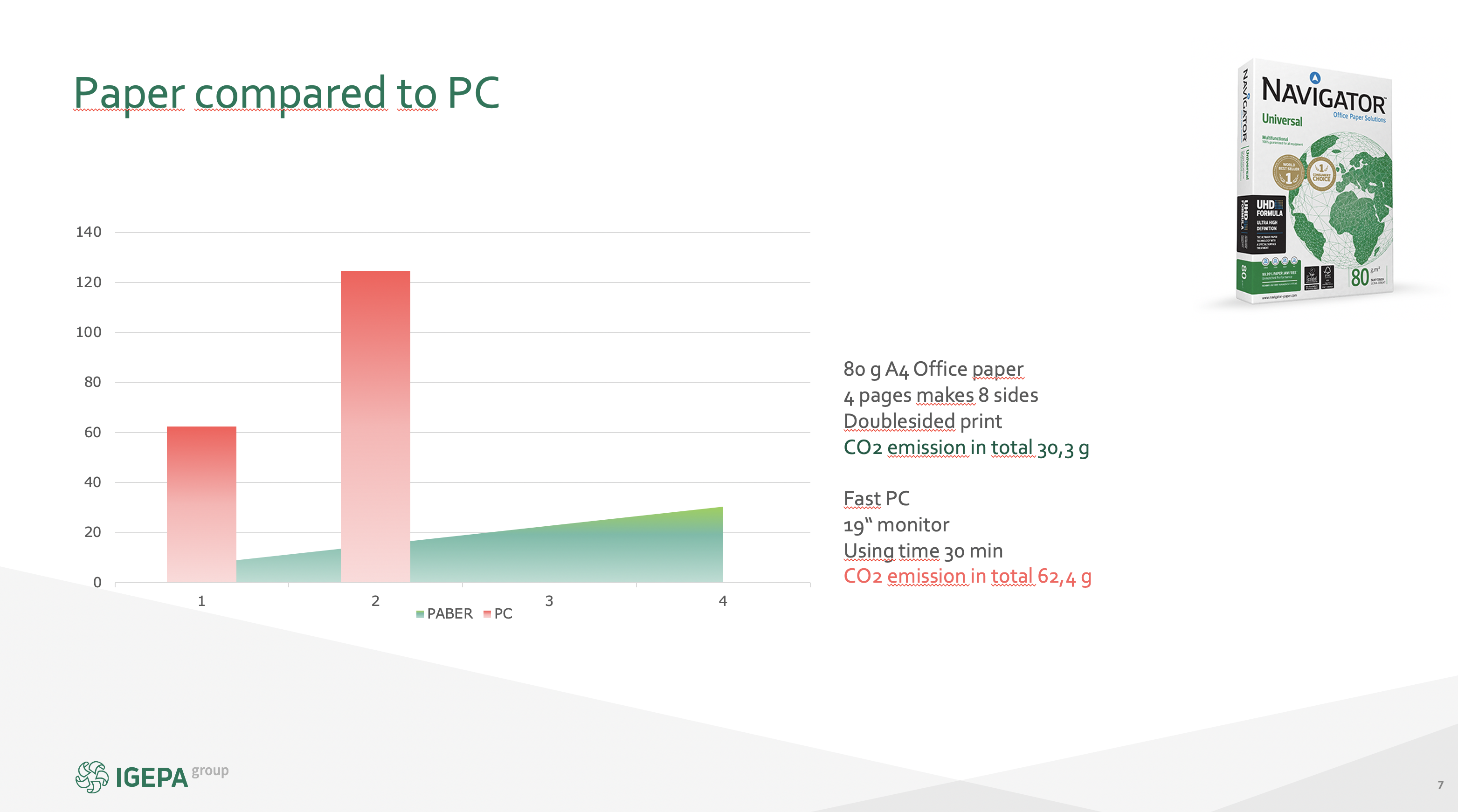And Yes, paper is a green material
Paper is primarily made from spruce and pine wood. Non-coniferous wood is used on a smaller scale to obtain wood fibre. Plant fibres like eucalyptus and cotton are also used. This process can be described in simple terms as follows: the tree is chopped down; then the logs are transported to a paper mill to be stripped of their bark.

What happens next depends on the type of pulp being manufactured. In the case of mechanical pulp, the entire piece of wood is used and no excess material is separated off. The term ‘wood-free pulp’ is used in the case of chemical pulp: a piece of wood is fed through a woodchipper, and during the chemical process the wood lignin (wood resin) is separated out. Cellulose is produced as a result. For the record, lignin is used for the reproduction of energy. The cellulose, along with the required additives, moves on to the paper machine. The mass is transported at around 60 km/h across a belt dryer, during which all water is drained. The total mass of water is around 97% in the first stage. Next comes pressing and then drying at a high temperature, followed by the coating of the paper, then its calendering and finally its cutting into smaller reels or sheets.
It is evident that manufacturing paper requires a lot of raw materials, water and energy. However, it can be said that paper today is environmentally friendly. It is not only environmentally friendly in its reuse of materials and its biodegradability, but also in the manufacturing process as a whole. There are extremely strict environmental requirements on manufacturing, and any infringement will cost a company millions of euros in fines. Consumer awareness has increased and green manufacturing has become a powerful selling point. Manufacturers want to show that they are doing more than is required by legislation alone. They consider environmental impact and look for ways of improving their environmental performance. They deploy environmental management systems and green labels to achieve this.
All large manufacturers are beholden to the environmental management system standard ISO 14001, which establishes requirements for environmental management. Every requirement must be met in order to obtain the certificate. Additionally, a variety of green labels are used. The most prominent first label type complies with the ISO 14024 standard: the green label entitled the ‘EU Ecolabel’; in the Nordic countries it is widely known as the Nordic Swan. In addition to manufacturing requirements, requirements of raw materials have become a hot topic. A forest management certificate entitled the FSC and/or PEFC has been adopted which ensures that forests are managed in accordance with internationally accepted standards. Obtaining the FSC ensures that forests are managed in a way that preserves biodiversity and demonstrates sustainable practices, in addition to shoring up financial interests. Raw materials, also known as adequate forest resources, are the greatest asset of paper manufacturers. There can be no manufacturing or profits without these materials. The optimal method is to stockpile raw materials from within a 150-km radius. The largest European and Scandinavian manufacturers have been operating for more than a hundred years and they have substantially increased forest resources. The FSC certificate is also issued in regard to recycled raw materials.
Paper can be recycled up to seven times in most cases. Recycled paper is still suitable for printing in the first stage, while in the final stage it is adequate for the protective packaging of a product (e.g. recycled egg cartons). Consumers have clearly indicated their preference in this regard. Recycled raw materials are highly sought after and demand is only increasing. The percentage of plastics will hopefully decrease even more. We should remember that when packaging is no longer required, we must continue to be responsible, with the first presumption here being that paper, cardboard and paperboard should be collected separately and placed in a designated container or taken to an appropriate collection point. Everything after that is in the hands of handlers and manufacturers.

The golden rules of sorting waste can be found on the Ministry of the Environment website, or simply by using a search engine. Moreover, did you know that the carbon footprint of a simple web search is the same as boiling enough water for a pot of tea or driving a car 16 metres? That might not seem like much, but consider this: 80% of all web data are videos, 60% of which are not downloaded, but rather streamed on Netflix, YouTube or Vimeo. This produced 300 million tonnes of CO2 in 2018, which is the same amount generated by the whole of Spain. People still say that by reading online, they are “keeping a tree standing in the forest”.
But let’s compare paper to computers.Manufacturing one 80-gram A4 piece of paper emits around 5 grams of CO2. Double-sided printing with a regular printer emits around 2.58 grams of CO2. Reading in detail for half an hour covers, on average, eight pages (four pieces of paper in total). That is a total of 30.3 grams of CO2. A computer with a high-speed processor (and who wants a slow one?) and a 19-inch screen emits, on average, 124.7 grams of CO2 every hour. Since we are talking about 30 minutes, that amounts to around 62.4 grams of CO2. As such, papers appears to be a rather green material.
Sten Martin
Sales Director at Igepa Libra Vitalis

